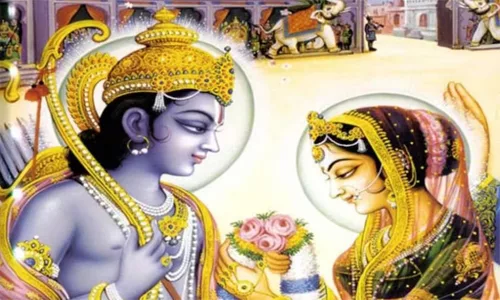 Vivah Panchami marks the sacred day when Sita Devi married Sri Rama, during Margashirsha masa.
Vivah Panchami marks the sacred day when Sita Devi married Sri Rama, during Margashirsha masa.
According to historian Will Durant, in native countries, the word “marriage” is synonymous with “to try.”
In Arabic, the word “nikhaha” means intercourse. In that tradition, marriage is not a samskara; it’s a contract.
Within the Dharma tradition, “vivaha” and “lagna” are the words used to signify girl and boy coming together for a lifetime and beyond.
Therefore, we still celebrate the vivaha samskara of Sri Sita & Rama, Tulsi-Shaligram, Rukmini Kalyana or Shakti & Shiva because their vivaha is timeless.
Sita’s vivaha is unique and can only be worshiped, emulating her ideas is beyond human comprehension. She knew Vivaha with Sri Rama was not easy but that was not even her consideration rather willing acceptance.
Sri Rama was more of a responsible king than simply being a Pati. Sri Sita had to endure separation from Sri Rama in Valmiki’s Ashrama, as a consequence of loose talk among Ayodhya’s citizens. Her message to Sri Rama was unique. She stood by him, urging him to treat his citizens as his children and care for them well, even though the citizens had caused her insult and separation. Of course, the time they spent with each other was beautiful and heart-melting.
Valmiki Maharshi, well aware of their limited time together in Ayodhya, quantifies their togetherness in terms of months, underlining that they spent many months together.
When Hanumana saw Sita Devi for the first time, he approved the vivaha of Sita-Rama in his heart and expressed, “If Sri Rama has to turn the entire universe upside down to get back Sita Devi, it is still not a significant endeavor.” What an appreciation!
The great Janaka Maharaja, who was entirely indifferent to self-identity, having given up false ahankara and mamakara, who had even taught great Sukadeva Goswami about vairagya, couldn’t hold back expressing to Sri Rama about Sita: “Mam suta dharmacharini tava.” My daughter will be a great friend in your dharmik journey. Their profound journey is reflected in the fact that we, as dharmik followers, only chant and worship Sri Sita-Rama in every facet of our lives.
Our tradition arranges “Sita Kalyana” to invoke auspiciousness in every vivaha. So, Sita Kalyana inspires everyone to go beyond the confines of marriage or nikah, embracing “Kalyana”—a symbol of all that is good and auspicious.
– Govinda Das



